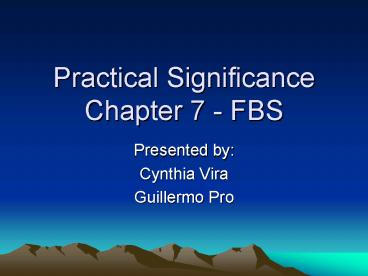Practical Significance Chapter 7 FBS PowerPoint PPT Presentation
1 / 9
Title: Practical Significance Chapter 7 FBS
1
Practical Significance Chapter 7 - FBS
- Presented by
- Cynthia Vira
- Guillermo Pro
2
Significance, What does it mean?
- Research hypothesis what we want or expect to
happen. - Remember that Null hypothesis the hypotheses
that are actually tested in inferential
statistics predicting zero differences or
relationship. - NHSST The Null hypothesis statistical
significance testing is the inferential
statistics process of making decisions about
whether to reject or not reject the null
hypothesis. - Once we have our data We can make a mistake!!
It is always conceivable that we can draw an
unusual, fluky sample from a population where the
null is true, and the an aberrant sample is so
unlikely that we erroneously decide to reject our
null hypothesis. Because we are using sample
data rather than population data, all we can do
is attempt to minimize (but never eliminate)
erroneous decisions. - What do the authors say? The indices of
Practical significance should be reported and
interpreted. The Task Force recommendations
affected the reporting expectations reported in
the revised APA (2001) Publication Manual, used
by more than 1,000 journals, although it has been
argued that the Manual should have gone further
in promulgating expectations for changed
reporting and interpretation practices.
3
Effect Sizes
- What is an Effect size? It is a statistic
quantifying the extent to which sample statistics
diverge from the null hypothesis. - The APA Task Force on Statistical Inference urged
authors to Always provide some effect-size
estimate when reporting a p value. - Furthermore, Reporting and interpreting effect
sizes in the context of previously reported
effects is essential to good research. - Failure to report effect sizes A defect in the
design and reporting of research. - Textbooks still emphasize NHSST over effect sizes
(Capraro Capraro, 2002) - P values The p value is a random variable that
varies from sample to sample, consequently, it is
not appropriate to compare the p values from two
distinct experiments, or from tests on two
variables measured in the same experiment, and
declare that one is more significant than the
other. - Three classes of effects
- a. uncorrected, standardized difference effect
sizes, - B. Uncorrected, variance-accounted for effect
sizes - C. Corrected, variance-accounted-for effect
sizes
4
Uncorrected, Standardized Difference Effect
SizesCorrected, Variance-Accounted-for Affect
Sizes
- Remember Statistical significance is not a
viable vehicle for testing result replicability. - When comparing results across studies using
different metrics, statisticians use two popular
standardized effect sizes, i.e. Glass , and
Cohens d. They do this by dividing the mean
difference of the experimental and the control
groups by some estimate of the sigma outcome
variable. - Uncorrected effect sizes for various research
designs can also be computed as analogs of r2.
5
Corrected, variance-accounted for Effect Sizes
- Corrected all samples have degrees of flukiness.
The only way to eliminate flukiness is to
collect population rather than sample data. Some
of the score variance, SD2, in the sample data
reflects true variance that exists in the
population but some of the SD2 in the sample does
not exist in the population and is called
sampling error variance. - Sampling error variance inflates effect sizes.
This is because r2, or Spearman p2 or R2 do not
take into consideration the fact that some of the
sample score variance does not exist in the
population and is instead peculiar to the given
sample.
6
Interpretation of Effect Sizes
- Interpreting Effect sizes with rigidity (example
of Cohens small, medium, and large, would
merely be being stupid in another metric. - There is no wisdom whatsoever in attempting to
associate regions of the effect-size metric with
descriptive adjectives such as small, medium,
large and the like. - What may be small to a sociologist may be
appraised a medium to a clinical psychologist.
7
Confidence Intervals
- Investigators would be misled less often if they
used confidence intervals to base their estimated
values of a hypothesis rather than using a null
hypothesis and all other possible alternatives. - Empirical studies of journals show that
confidence intervals are published very
infrequently.
8
Three Misconceptions about Confidence intervals
- 1. Researchers Consciously or unconsciously
interpret confidence intervals constructed using
large confidence levels (90-99) Being close to
100 never means that it is true 100 of the
time. - 2. Some researchers erroneously believe that CI
are just null hypothesis statistical significance
tests in a different guise. You can construct CI
completely absent of a null hypothesis, but you
cannot do NHSST without a null hypothesis. - 3. Some researchers interpret a CI in a given
study as if they were X certain that their
particular single interval captured the
population parameter. But the certainty level
involved in constructing a given sample CI
applies to the construction of infinitely many
CIs drawn from a population, and not to the
single CI constructed in a single sample.
9
Confidence Intervals for Effect Sizes
- If effect sizes are essential, and confidence
intervals are the best reporting strategy, then
the marriage of CIs and effect sizes seems
appealing. - The problem with computing a confidence interval
for an effect size is that a different formula
for computing and effect CI has to be used for
each of the infinitely many values of the effect
size.

